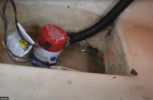rusty swivel
New Member
I'm wondering if anyone can identify what these are. I recently purchased an older but decent condition Sangstercraft 15.5'. One day as I went out to it to clear out water from recent rains, I notice its bilge wouldn't stop continuing to fill back up after pumping it out completely. (the bilge appears to be a small 25x30x10cm recess) It would take me quite a bit of time to pump, wait for it to slowly fill up again, pump, etc. When it finally stopped filling back up, I'd peer my head inside to see 2 small, maybe 1cm holes, on the side of the recess, one being maybe 2-3cm above the hull surface, and another maybe 2-3cm below the floor height. It seems rainwater flowed back into the sump and went into the void between the floor and hull. If these are OEM hull drainage holes, it just doesn't make sense that the bottom hole isn't larger and flush against the hull so ALL the water would flow into the bilge. Instead these holes seem to trap water.
Anyone familiar with what these may be and if they're not supposed to be there?
Thanks
video of it:
Anyone familiar with what these may be and if they're not supposed to be there?
Thanks
video of it:

